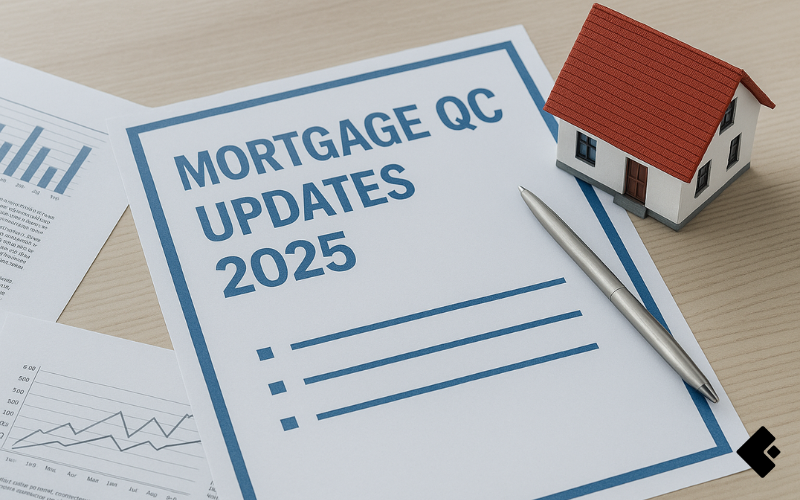Fannie Mae’s July 2025 Quality Insider and Selling Guide updates bring significant enhancements to Mortgage QC requirements. These changes tighten self-reporting timelines, expand occupancy reviews, and strengthen corrective action expectations. For lenders, the challenge is clear compliance must be proactive, not reactive.
At Frasco, our Mortgage Risk Mitigation services give lenders the tools and knowledge to meet these new Mortgage QC rules with confidence.
1. Mortgage QC Requirements: What’s New in 2025
The July 2025 updates modernize loan quality control by focusing on:
-
Timely self-reporting of loan defects
-
More flexible but documented reverifications
-
Detailed QC reporting with corrective action plans
-
Expanded occupancy scrutiny for all property types
-
Risk-based discretionary sampling for third-party originations
These changes show Fannie Mae’s focus on lender accountability and on reducing repurchase risk.
2. Self-Reporting Is Now More Time Sensitive
Lenders must now self-report loans with identified defects within 30 days of the QC report’s publication. This updated timeline ensures faster defect resolution and reduces exposure to repurchase requests. For many lenders, this means building tighter Mortgage QC processes to avoid falling behind.
3. Smarter Reverifications — More Flexible, More Thorough
Reverification requirements have been updated:
-
No longer limited to mail or fax—digital methods are acceptable.
-
All verification attempts (successful or not) must be tracked.
-
Loan files must document reverification efforts in detail.
This improves Mortgage QC integrity while giving lenders flexibility in execution.
4. Enhanced Mortgage QC Reporting with Action Plans
QC reports now must include:
-
Sampling strategies and rationale
-
Review summaries for random, discretionary, and TPO sampling
-
Three months of defect trends by category/subcategory
-
Written corrective action plans, including root cause identification, assigned personnel, resolution timelines, and monitoring processes
5. Expanded Prefunding & Occupancy Scrutiny
Prefunding QC reviews now cover all property types—primary homes, second homes, and investment properties. This change closes a common gap in borrower fraud and makes Mortgage QC more reliable.
6. Strategic Sampling for TPO and Elevated-Risk Loans
Discretionary QC sampling has been updated to focus on elevated-risk loans and third-party originations (TPOs). The new policy replaces the old “1-in-12” method. It now uses monthly risk-based sampling. This includes both full-file and component reviews.
How Frasco’s Mortgage Risk Mitigation Support These Demands
Frasco helps lenders adapt to these changes with industry-leading investigative services:
-
Occupancy Investigations — Validate actual borrower occupancy through field and desktop investigations, ensuring compliance with new QC requirements.
-
Forensic & Fraud Reviews — Detect borrower misrepresentation, fraud, and documentation discrepancies.
-
Due Diligence & QC Audits — Our tailored audits assess loan quality and compliance with a focus on sample selection, forensic fraud reviews, data integrity checks, and customizable reporting to meet client needs.
-
Loss Mitigation — Effective loss mitigation strategies are essential for minimizing losses on delinquent loans and preventing foreclosures. Services include income and asset reverifications, hardship reason confirmation, and social media searches.
Learn more: Frasco Mortgage Risk Mitigation
Frequently Asked Questions (FAQs)
Q1. What is the new 30-day self-reporting requirement?
Lenders must report any ineligible loans found in quality control within 30 days of the QC report.
Q2. Are traditional reverification methods still required?
No. Lenders may now use digital alternatives, but must track all verification attempts and outcomes..
Q3. Does occupancy verification apply to all property types in Mortgage QC?
Yes. Prefunding QC reviews may now include second homes and investment properties.
Q4. Why is discretionary sampling emphasized for TPO loans?
To better address elevated risks, replacing the outdated 1-in-12 sampling rule with targeted, risk-based reviews.
Q5. What should be included in a corrective action plan?
We should include a root cause analysis, assign responsibilities, detail resolutions, and establish a timeline for completing.
Conclusion:
The Mortgage QC landscape is changing—faster reporting, tighter occupancy reviews, and stricter corrective actions are now the standard. Lenders who adapt quickly will not only avoid compliance issues but also strengthen their risk management practices.
At Frasco, we help you stay one step ahead. Our Mortgage Risk Mitigation service gives you the tools and knowledge to stay compliant. It helps reduce repurchase risk and protect your lending operations.
Want to Learn More?
At Frasco, we believe knowledge is the foundation of stronger, smarter lending practices. That’s why we provide resources to help lenders deepen their understanding of risk mitigation and compliance.
📄 Download our white paper: Unlocking Success: 3 Keys for Maximizing Occupancy Verification in Mortgage Lending
Stay Updated: Get real-time insights, the latest blogs, and updates on upcoming industry events.
👉 Follow Frasco on LinkedIn
Contact Us Today
Frasco® Mortgage Risk Mitigation delivers ethical and efficient solutions tailored to your needs. Have questions or want to discuss your investigative needs further? Schedule a call with one of our experts today to find the answers you’re looking for.
If you know a company that could benefit from our investigative services, Submit a Referral Here to help them make informed decisions and prevent costly risks.
Disclaimer: This blog post is for informational purposes only and should not be considered legal advice. Please consult your general counsel for specific legal guidance. Frasco investigators are licensed, and our operations comply with US industry, federal, state, and local laws.

